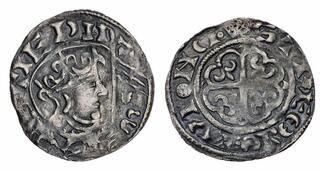| Spink > Auction 24004 | Auction date: 4 April 2024 |
| Lot number: 54 Price realized: 2,400 GBP (Approx. 3,016 USD / 2,802 EUR) Note: Prices do not include buyer's fees. | Show similar lots on CoinArchives Find similar lots in upcoming auctions on |
| Lot description: Stephen (1135-1154), Northern Variants, 'Flag/Ornaments Type', Penny, c. 1145-1149, York, Stefan [?] [?], [+] STIEPN-E the E recumbent and outward facing, crowned and draped bust right, holding flag or banner before, rev. ST - EO IO : + VI - EI, cross moline with inward fleurs in angles, 1.05g [16.20grns], 4h (SCBI 20 [Mack], 617; Williams III, 442; North 919; Spink 1313), straightened and the key details of portrait reworked and retoned, residual struck details fine to nearing very fine, very rare. In the footnote to our Williams dispersal (Part 3, Spink Auction, 26 September 2018, lot 442), we commented: "It was at the end of the 19th century that A E Packe suggested that the the flag which replaces the sceptre on the obverse of these coins represents the standard erected, under the directions of Archbishop Thurstan, on the battlefield at Northallerton when a Yorkshire army defeated a Scottish invasion force under king David (the 'Battle of the Standard'), in 1138. (A E Packe, 'The Coins of Stephen' in NC 3rd series. 16 (1896), 68, and others) , , Nearly 100 years later, Peter Seaby suggested the banner represents the papal standard presented to Stephen at the time of the Second Crusade in 1147. (P Seaby, 'A new 'Standard' type for the reign of king Stephen' in BNJ 53 (1983) pp.14-18). , , More recently George Boon pointed out that the equestrian figure of the king on the reverse of the Second Great Seal of Stephen (in use after 1141), also depicts the king carrying a streaming standard, instead of the usual sword. , , The letters and symbols on the reverse have not been fully interpreted. A few reverse dies appear to show a literate mint signature on ev, but the majority, have an apparently meaningless combination of letters and symbols or ornaments. We have taken the largest ornament to signify the end of the 'legend'. Several examples clearly show the shield decorated with roundels, which might represent the shield of Boulogne. The symbol in the obverse field has been described as a star but it appears more complex than that. , , There are at least 40 Pennies and 10 cut halfpennies of the type known, and the letters and symbols vary considerably. The 23 Pennies listed in detail by Allen (NC 2006, pp. 304-306), are struck from 20 different pairs of dies, suggesting that surviving examples are only a small representation of a prolific coinage and supporting Blackburn's conclusion that the flag type was the principal York coinage of the second half of the 1140s. Estimate: £2400 - £3000 |  |



